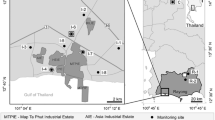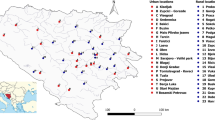Abstract
The level of air pollution around the automobile mechanic workshops has been generally overlooked. This study, examined the level of trace metals in automobile mechanic workshops and the suitability of using transplanted lichen thalli of Lepraria incana for measuring air pollution in such areas. Samples of the lichen thalli were transplanted into seven different sites and were attached to the bark of trees at each site. The samples were harvested from the sites after 3-month exposure. Concentrations of Pb, Cu, Cd, Fe, Zn, and S content were determined using an atomic absorption spectrophotometer. Results showed that there was a significant difference in the trace metals concentrations across the sites (p < 0.05). The analyzed lichen samples showed a range of 91.26–119.35 ppm for Fe, 30.23–61.32 ppm for Zn, 1.25–2.45 ppm for Cu, 0.017–0.043 ppm for Cd, 0.018–0.051 ppm, and 0.37–0.42 ppm for S. From the study, sites 6 and 7 presented higher concentrations of Cd, Pb, and Zn than other sites. The enrichment factor calculated showed that Zn, Cd, and Pb were greatly enriched from the workshops. The trend in the concentration of these heavy metals suggests that activities in these workshops might become a major source of certain heavy metals in the environment and if the pollution activities persist, it might become worrisome over time.







Similar content being viewed by others
References
Aderinola, O. J., Ckarke, E. O., Olarinmoye, M. O., Kusemiju, U., & Anatekhai, M. A. (2009). Heavy metals in surface water, sediments, fish and periwinkles of Lagos Lagoon. American-Eurasian Journal of Agriculture and Environmental Sciences, 5(5), 609–617.
Ajasa, A. U. O., Bello, M. O., Ibrahim, A. O., Ogunwande, I. A., & Olawore, N. O. (2004). Heavy trace metals and macronutrients status in herbal plants of Nigeria. Food Chemistry, 85, 67–71.
Chipev, N., & Kovachev, A. (2006). Preliminary data on heavy metal contents in lichens from the Livingston Island (the Antarctic). Bulgarian Antarctic Research: Life Sciences, 2, 106–109.
Conti, M. E., & Cecchetti, G. (2001). Biological monitoring: lichens as bioindicators of air pollution assessment—a review. Environmental Pollution, 114, 471–492.
Dolan, L. M. J., Bohemen, H., Whelan, P., Akbar, K. F., & O’Malley, V. (2006). Towards the sustainable development of modern road ecosystem. In J. Davenport & J. L. Davenport (Eds.), The ecology of transportation: managing mobility for the environment (pp. 275–331). Netherlands: Springler.
Ekong, F. U., Michael, G. U. S., & Michael, U. S. (2012). Assessing the effects of mechanic activities on Uyo air environment. Ethiopian Journal of Environmental Studies and Management, 5(1), 74–85.
Fatoba, P. O., Ogunkunle, C. O., & Okewole, G. A. (2012). Mosses as biomonitors of heavy metals deposition in the atmosphere. International Journal of Environmental Science, 1(2), 56–62.
Fereidoun, H., Nourddin, M. S., Rreza, N. A., Mohsen, A., Ahmad, R., & Pouria, H. (2007). The effect of long-term exposure to particulate pollution on the lung function of Teheranian and Zanjanian students. Pakistan Journal of Physiology, 3(2), 1–5.
Figueiredo, A. M. G., Alcalá, A. L., Ticianelli, R. B., Domingo, R., & Saiki, M. (2004). The use of Tillandsia usneoides L. as bioindicator of air pollution in São Paulo, Brazil. Journal of Radioanalytical and Nuclear Chemistry, 259, 59–63.
Frati, L., Brunialti, G., & Loppi, S. (2005). Problems related to lichen transplants to monitor trace element deposition in repeated surveys: a case study from Central Italy. Journal of Atmospheric Chemistry, 52, 221–230.
Georgopoulos, P. G., Roy, A., Lioy, M. J., Opiekun, R. E., & Lioy, P. J. (2001). Environmental copper: its dynamics and human exposure issues. Journal of Toxicology and Environmental Health, 4, 341–394.
Hall, J. B. (1969). The vegetation of Ile-Ife. University of Ife Herbarium Bulletin 1.
Harrison, B. J. (1998). Copper Information Sourcebook. Vancouver, BC, Canada: University of British Columbia.
Herpin, U., Berlekamp, J., Markert, B., Wolterbeek, B., Grodzinska, K., & Siewers, U. (1996). The distribution of heavy metals in a transect of the three states the Netherlands, Germany and Poland, determined with the aid of moss monitoring. Science of the Total Environment, 187, 185–198.
Ho, Y. B., & Tai, K. M. (1998). Elevated levels of lead and other metals in roadside soil and grass and their use to monitor aerial deposition in Hong-Kong. Environmental pollution, 49, 37–51.
Jackson, L. L., Geiser, L., Blett, T., Gries, C., & Haddow, D. (1996). Biogeochemistry of lichens and mosses in and near Mt. Zirkel Wilderness, Routt National Forest, Colorado: Influences of coal-fired power plant emissions. USDI-US Geological Survey Open-File Report 96–295. Available on-line at url:<http://www.nacse.org/lichenair. Accessed 20 Sep 2012.
Mikhailova, I. N. (2002). Vegetative reproduction of Hypogymnia physodes (L) under conditions of air pollution. The Lichenologist, 82, 243–249.
Mohammed, S., Nkobobi, M., Georges-IVO, E., Ekosse, O. T., & Julius, A. (2005). Soil Heavy metal concentration patterns at two seed zones along the Gaborone-Tlokweng Border post Highway. Southeast Botswana. Journal of Applied Science and Environmental Management, 10(2), 135–143.
Olowoyo, J. O., van Heerden, E., & Fischer, J. L. (2010). Investigating Jacaranda mimosifolia tree as biomonitor of atmospheric trace metals. Environmental Monitoring and Assessment, 164, 435–443.
Pawlik-Skowronska, B., Wojciak, H., & Skowronsk, T. (2008). Heavy metal accumulation, resistance and physiological status of some epigeic and epiphytic lichens inhabiting Zn and Pb polluted areas. Polish Journal of Ecology, 56(2), 195–208.
Poblet, A., Andrade, S., Scaqliola, M., Vodopi vez, C., Curtosi, A., Pucci, A., et al. (1997). The use of epilithic Antarctic lichens (Usnea aurantiacoatra and U. Antartica) to determine deposition patterns of heavy metals in the Shetland Island, Antarctica. Science of the Total Environment, 207, 187–194.
Rayson, M. J. T. (1990). An investigation into the effects of vehicular pollution on the U.K. and North American environments. MSc. Dissertation. Department of Chemical Sciences, University of Surrey, UK.
Richardson, D. H. S. (1992). Pollution monitoring with lichens. Naturalists’ Handbooks 19 (p. 76). Ltd. Slough, England: Richmond Publishing Co.
Richardson, D. H. S., & Nieboer, E. (1983). Ecophysiological responses of lichens to sulfur dioxide. Journal of the Hattori Botanical Laboratory, 54, 331–351.
Rosenstock, L. (2003). The environment as a cornerstone of public health. Environmental Health Perspectives, 111(7), A376–A377.
Rühling, Å. (1994). Atmospheric heavy metal deposition in Europe-estimation based on moss analysis. Nord 1994:9. Nordic Council of Ministers, Copenhagen.
Sax, N. I. (2001). Industrial Pollution, 4th ed., Van Nost and Reinhold Ltd.
Scerbo, R., Ristori, T., Possenti, L., Lampugnani, L., Barale, R., & Barghigiani, C. (2001). Lichen (Xanthoria parientina) biomonitoring of trace element contamination and air quality assessment in Pisa Province (Tuscany, Italy). Science of the Total Environment, 286, 27–40.
Schell, L. M., Gallo, M. V., Denham, M., & Ravenscroft, J. (2006). Effects of pollution on human growth and development: an introduction. Journal of Physiological Anthropology, 25, 103–12.
Spiro, D. J., Weiss, O. W., Purvis, I., Mikhailova, B. J., Williamson, B. J., Coles, B. J., et al. (2004). Lead isotopes in lichen transplant around a Cu smelter in Russia determined by MC-ICP- MS reveal transient records of multiple sources. Environmental Science and Technology, 38, 6522–6528.
Uzoije, U. (2005). The impact of Urban runoff on Ogbor River, Department of Environmental Technology, Federal University of Technology, Owerri, Nigeria.
WHO, (2010). World Health Organization air quality: volcanic ash cloud over Europe. Retrieved from http://www.euro.who.int/en/whatwe- do/health-topics/environmental health/airquality/volcanic-ash-cloudover- Europe. Accessed 18 Oct 2012.
WRI. (1992). World Resources Institute, in collaboration with the United Nations Environment Programme and the United Nations Development Programme. New York, NY, USA: Oxford University Press.
Author information
Authors and Affiliations
Corresponding author
Rights and permissions
About this article
Cite this article
Odiwe, A.I., Adesanwo, A.T.J., Olowoyo, J.O. et al. Assessment of trace metals using lichen transplant from automobile mechanic workshop in Ile-Ife metropolis, Nigeria. Environ Monit Assess 186, 2487–2494 (2014). https://doi.org/10.1007/s10661-013-3555-y
Received:
Accepted:
Published:
Issue Date:
DOI: https://doi.org/10.1007/s10661-013-3555-y




